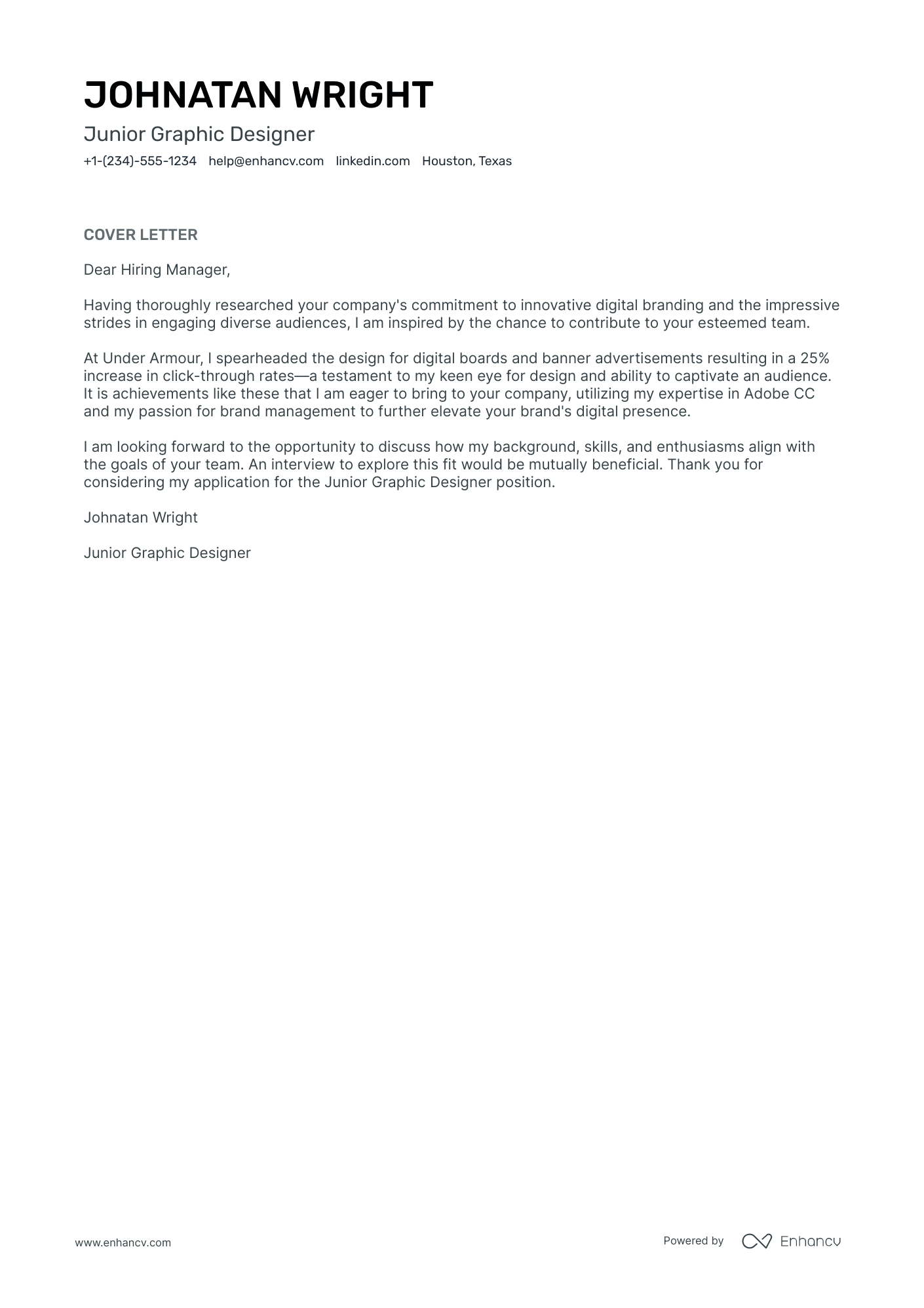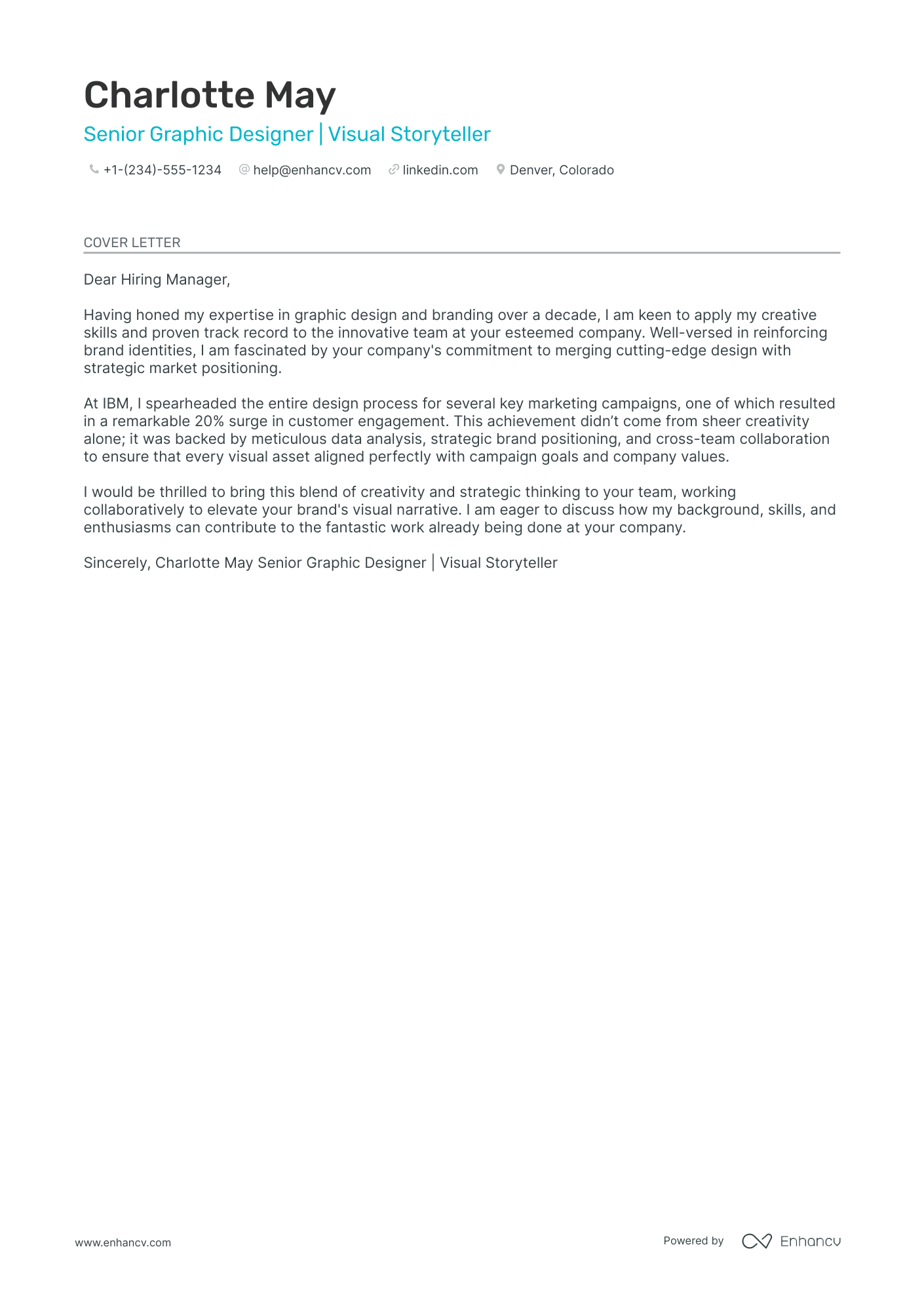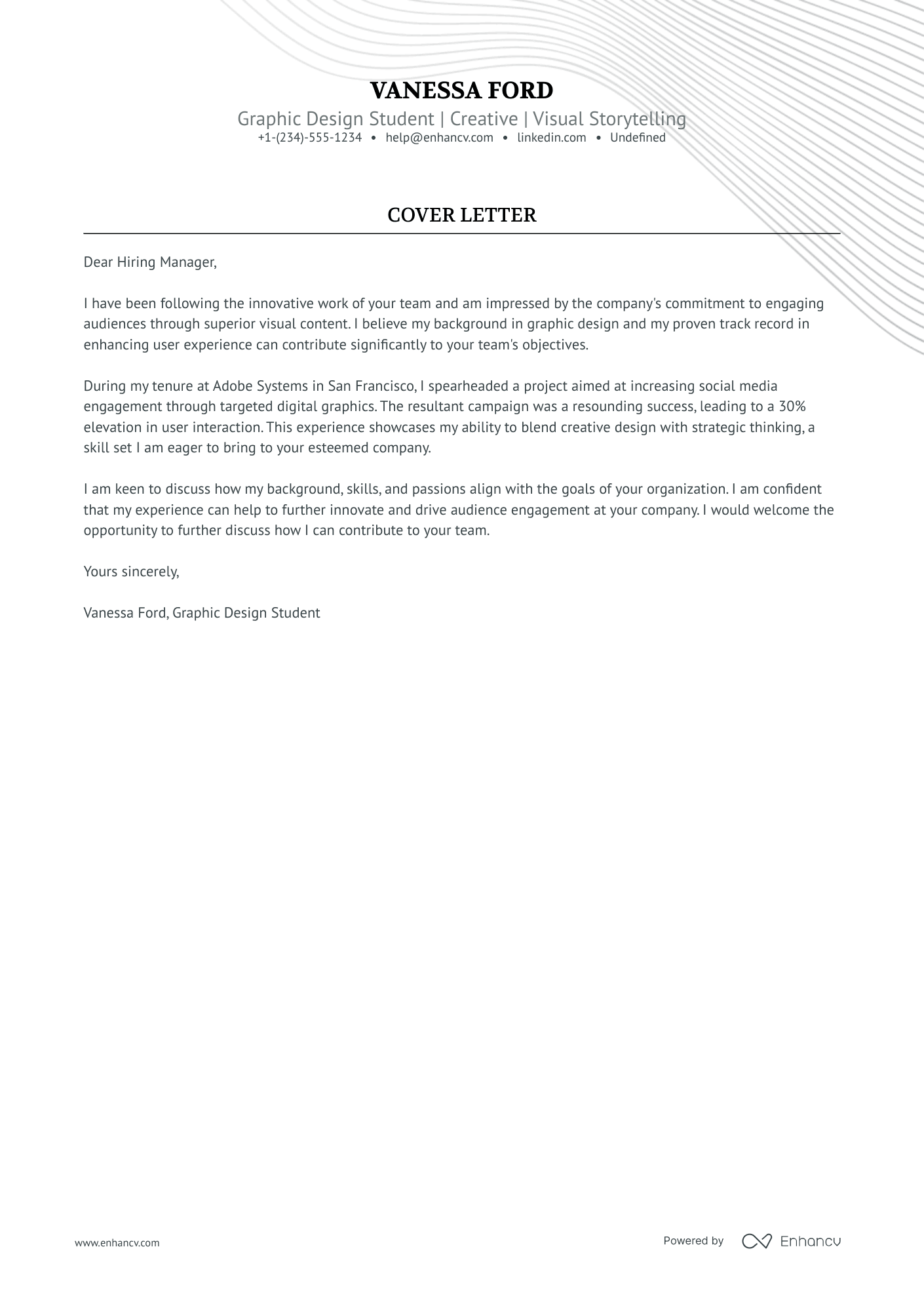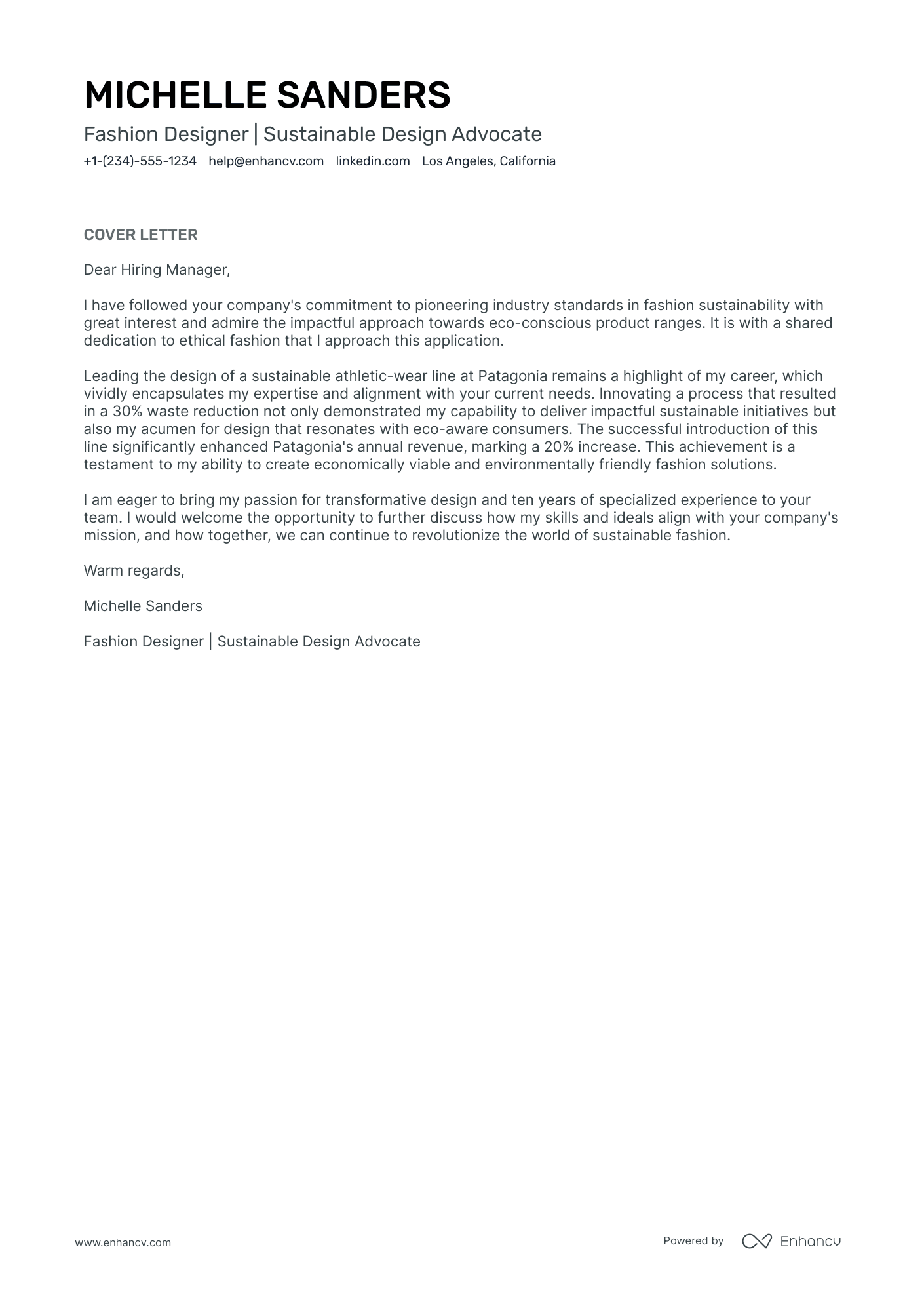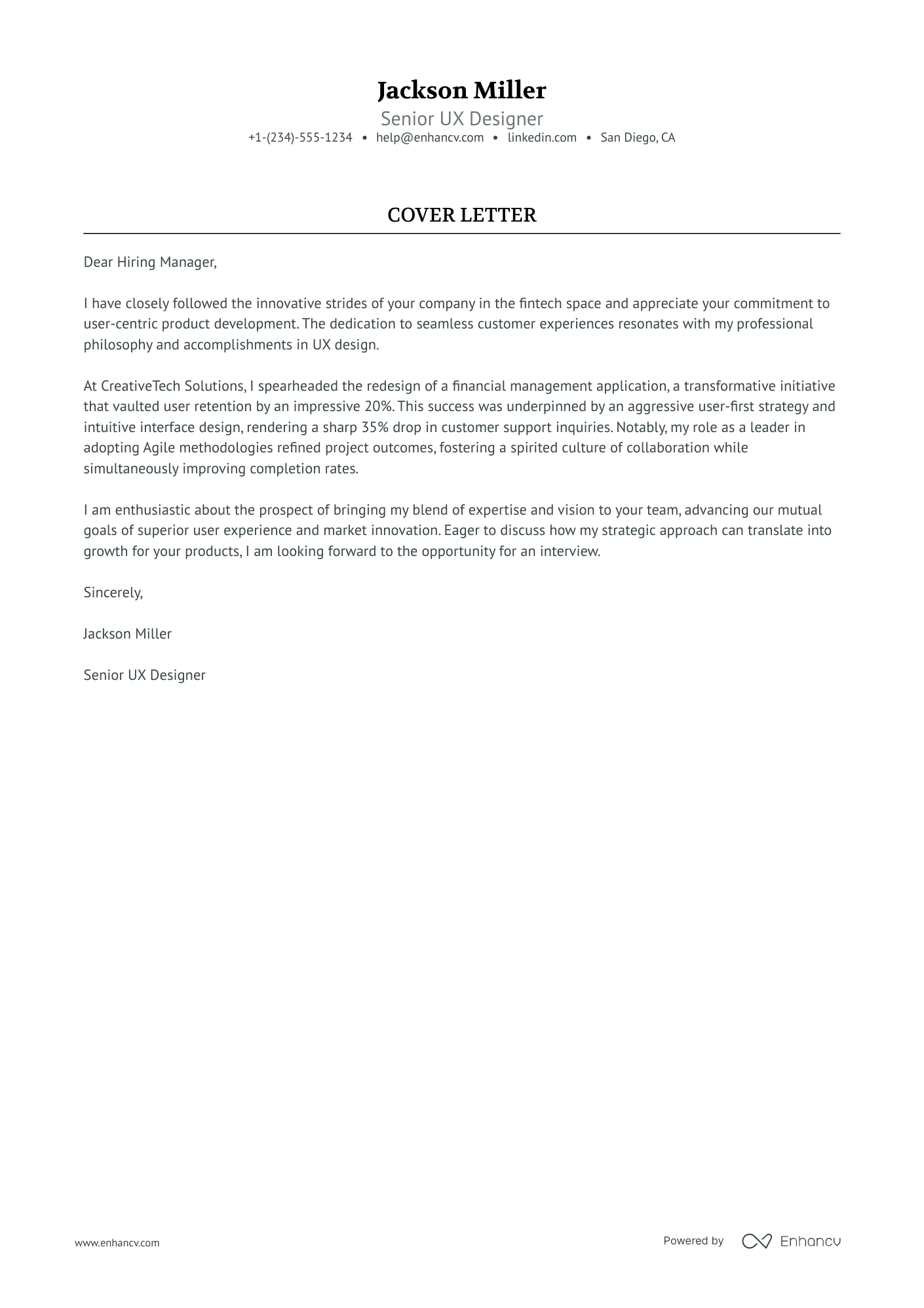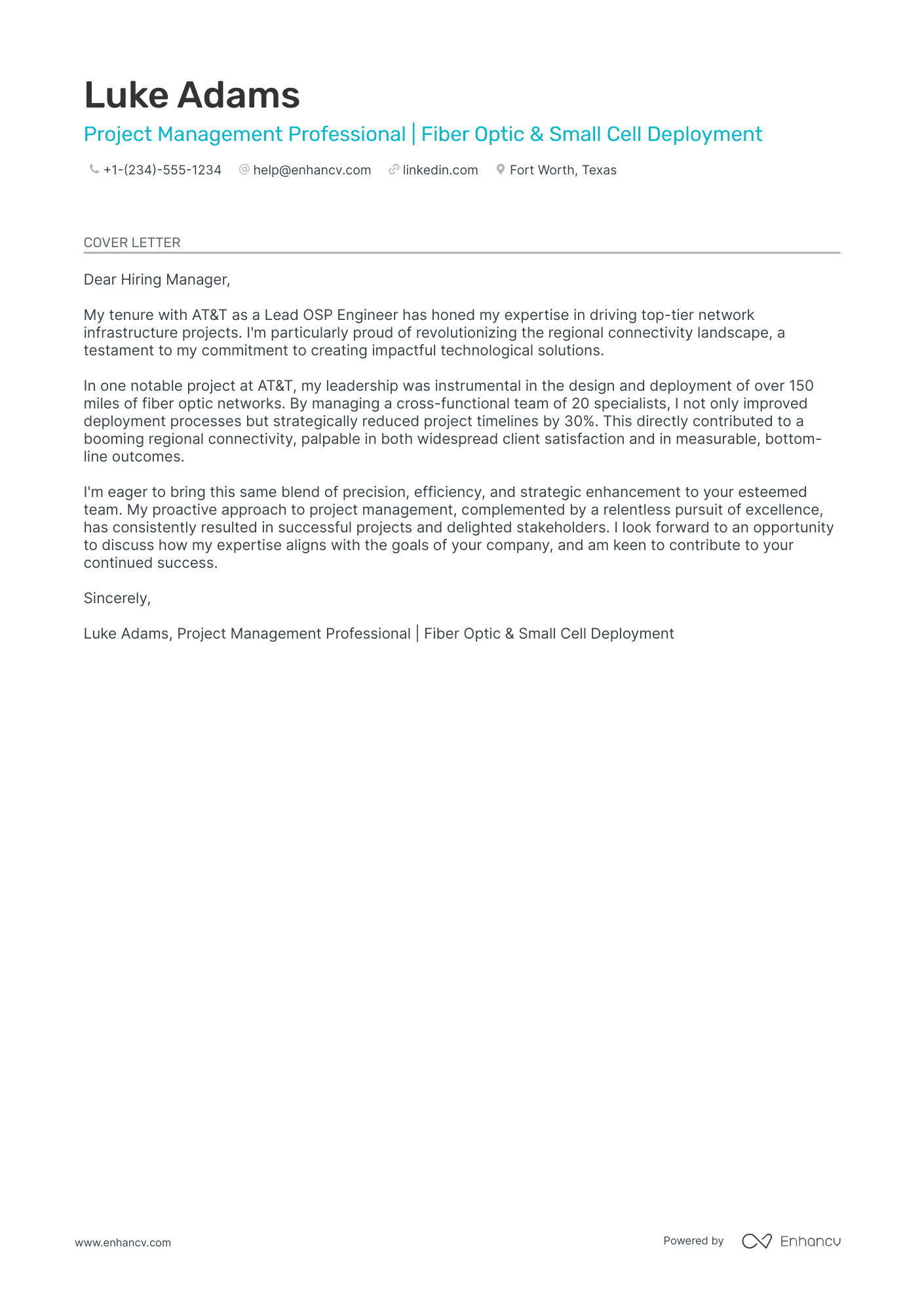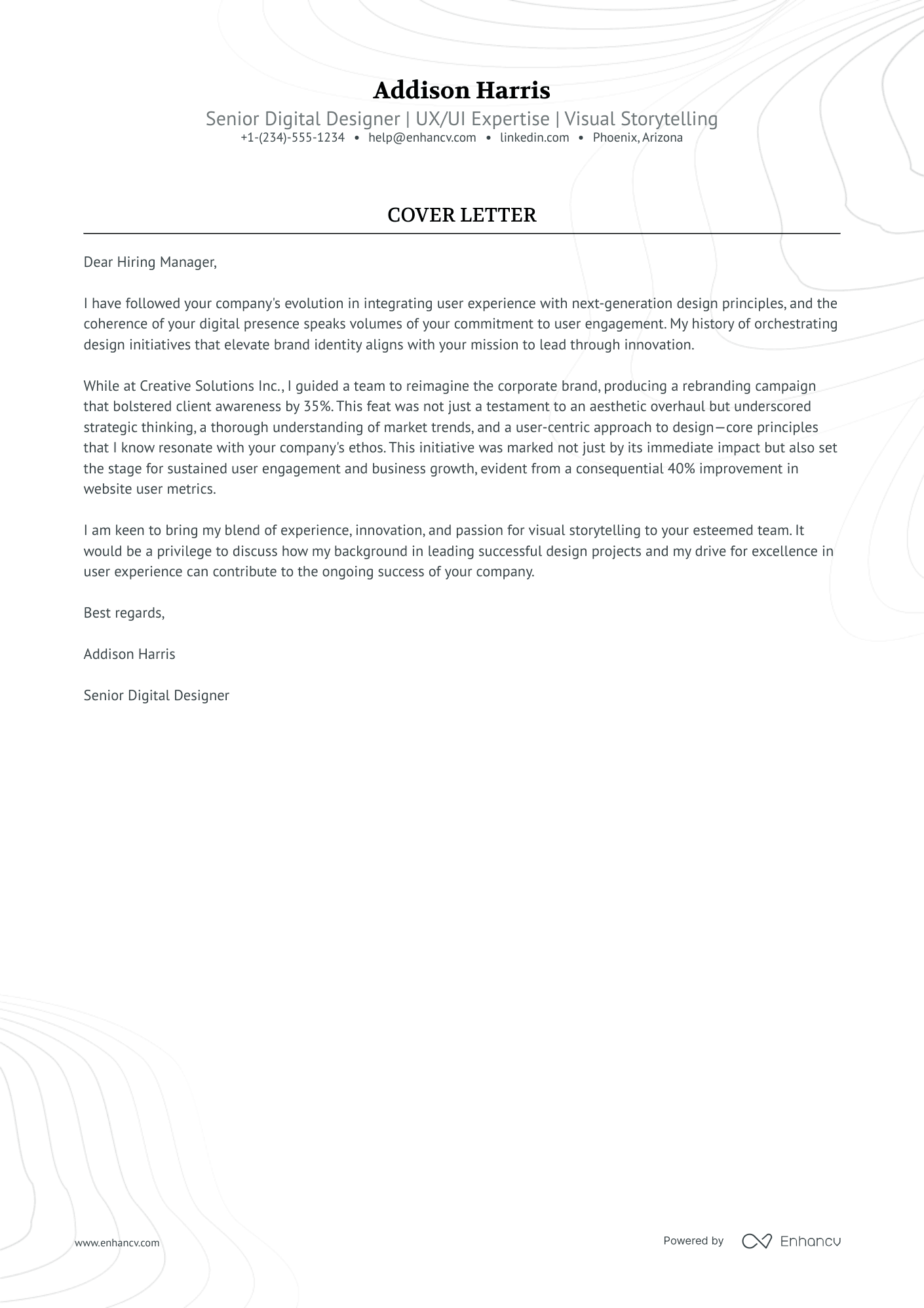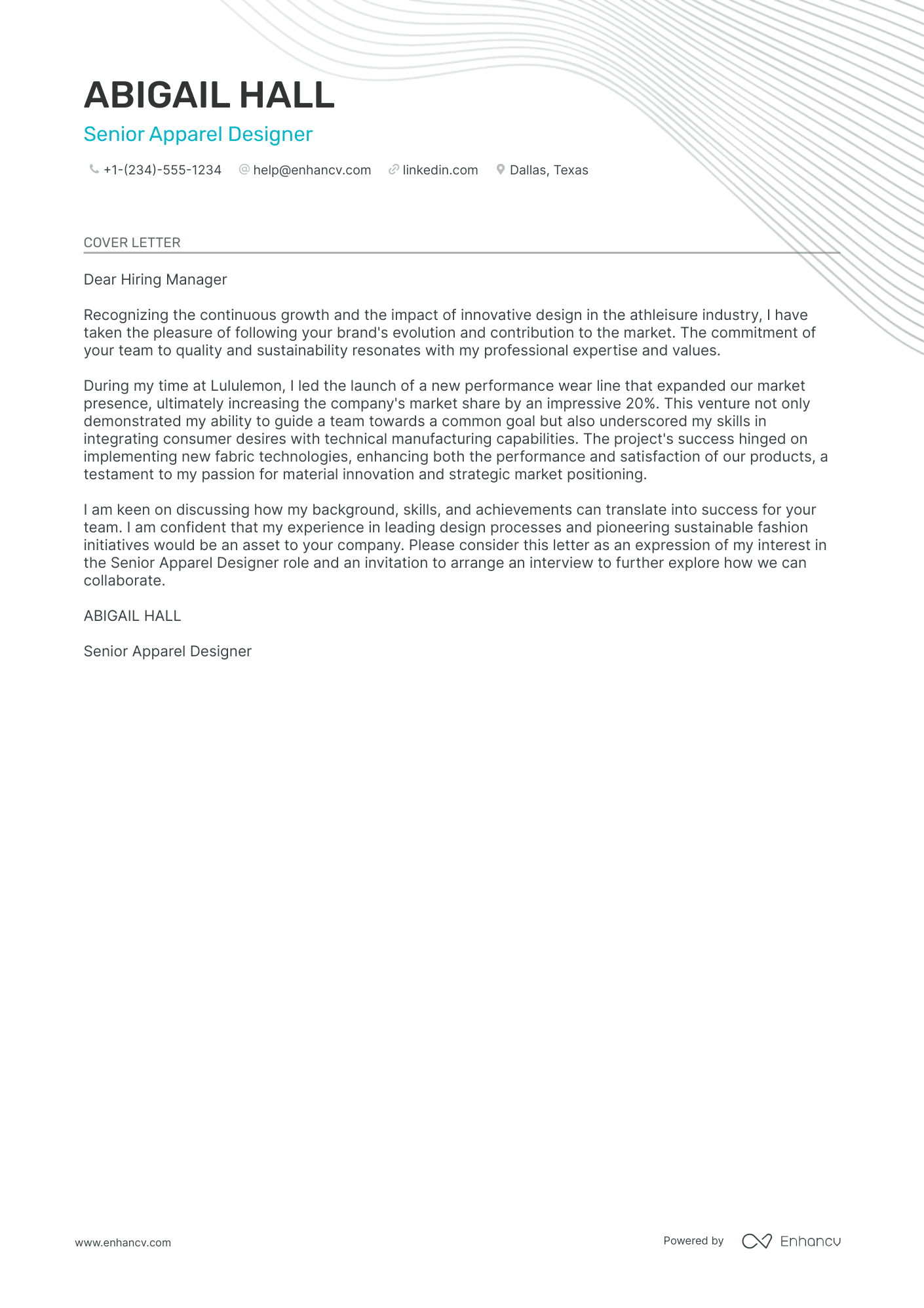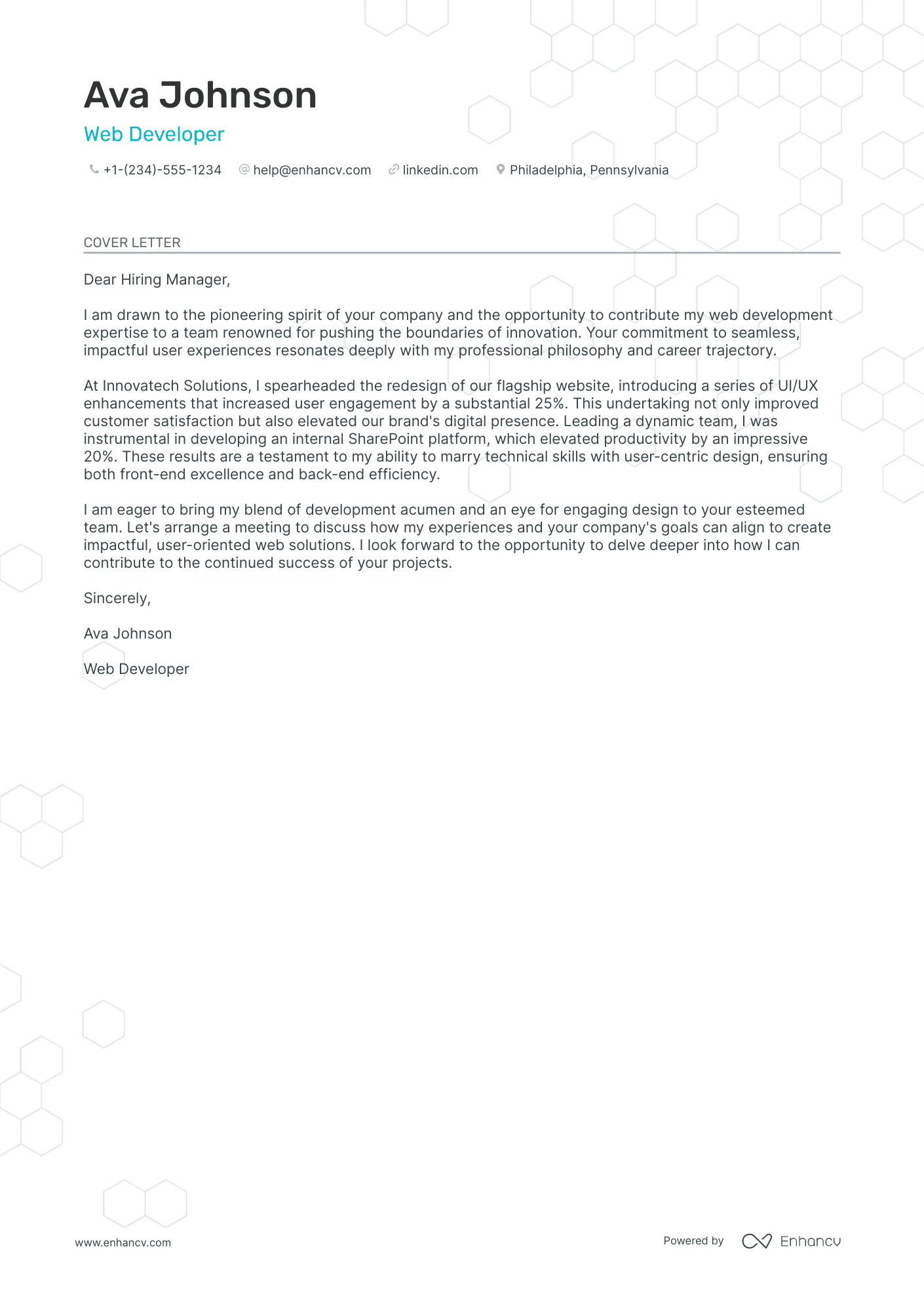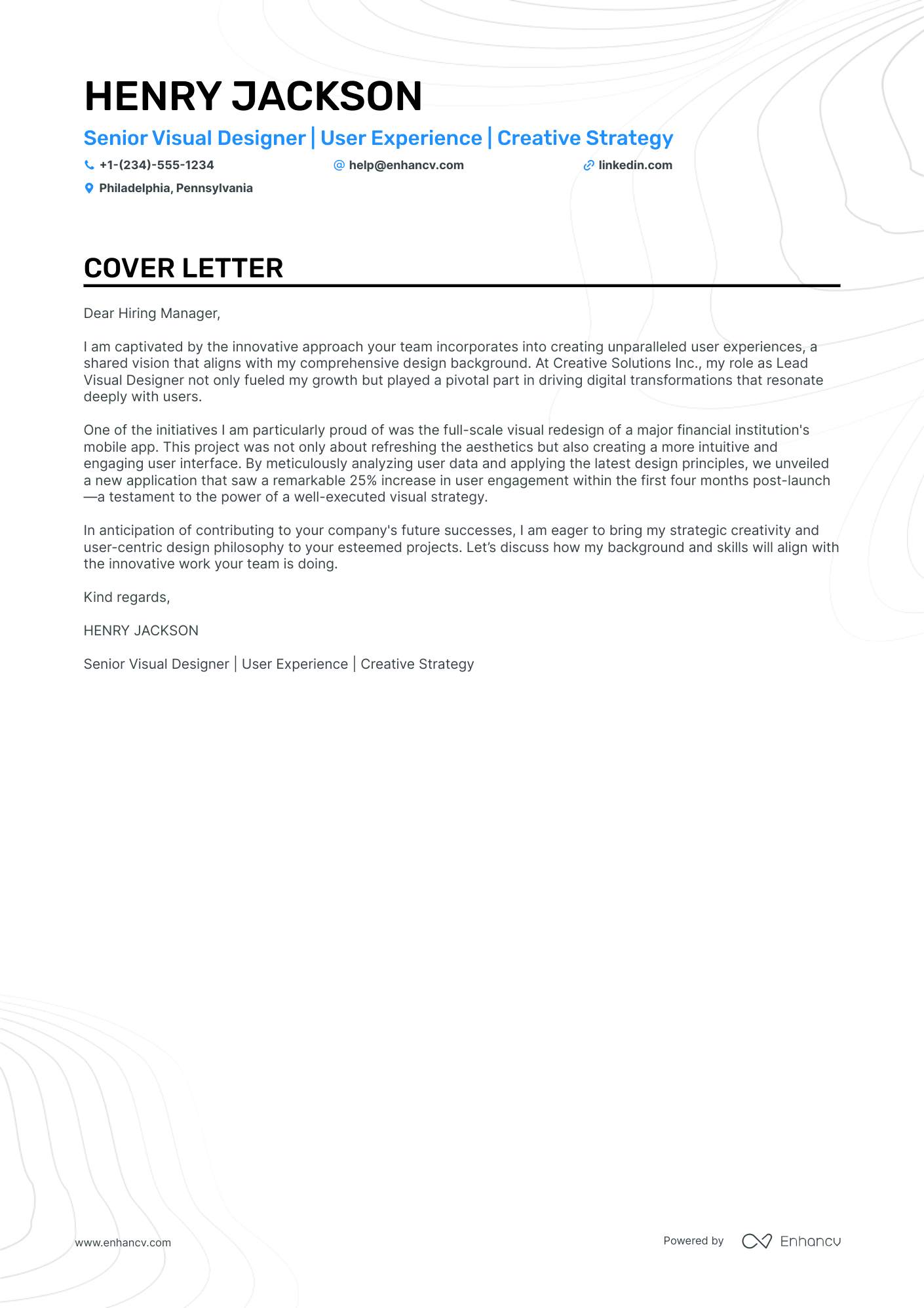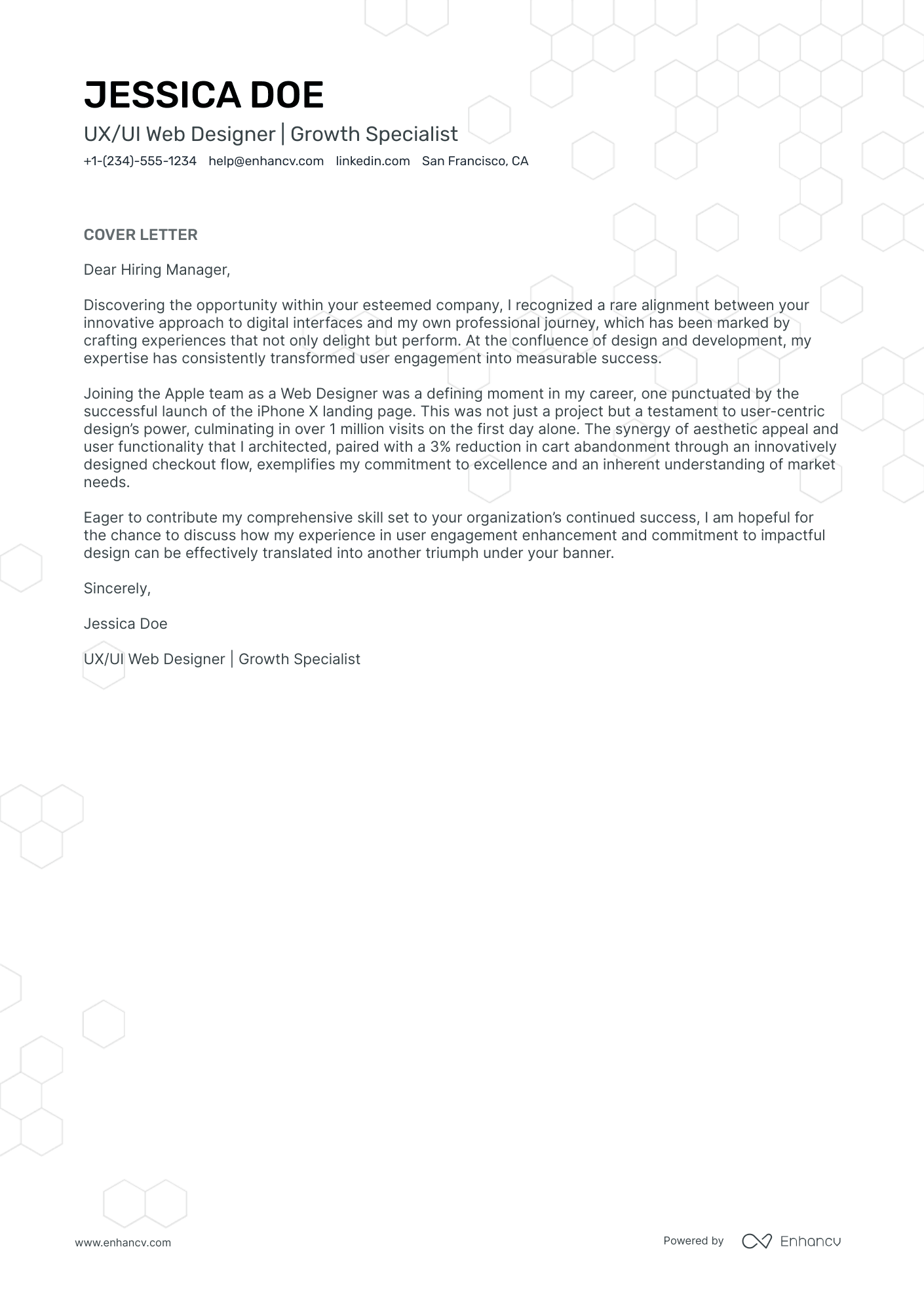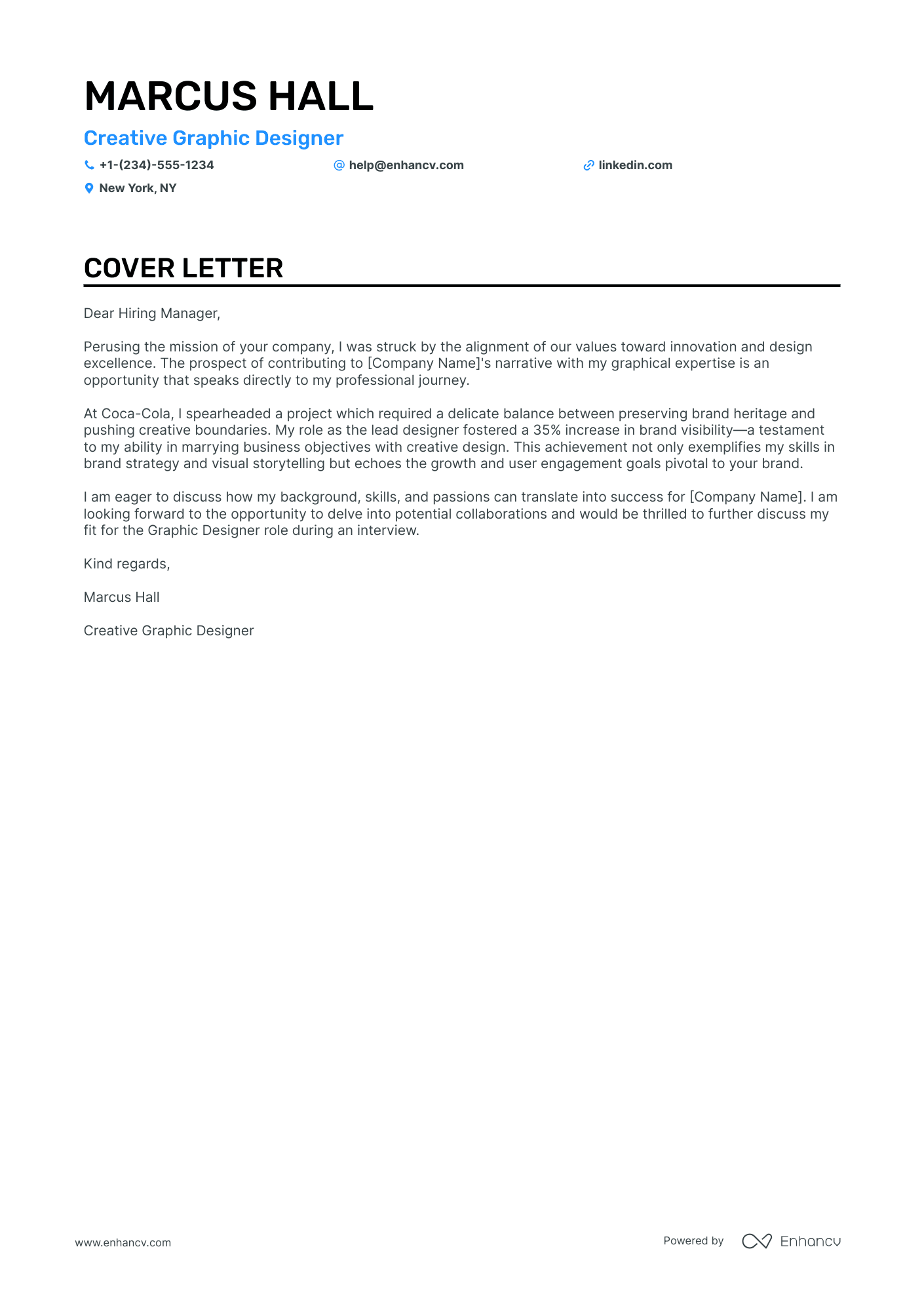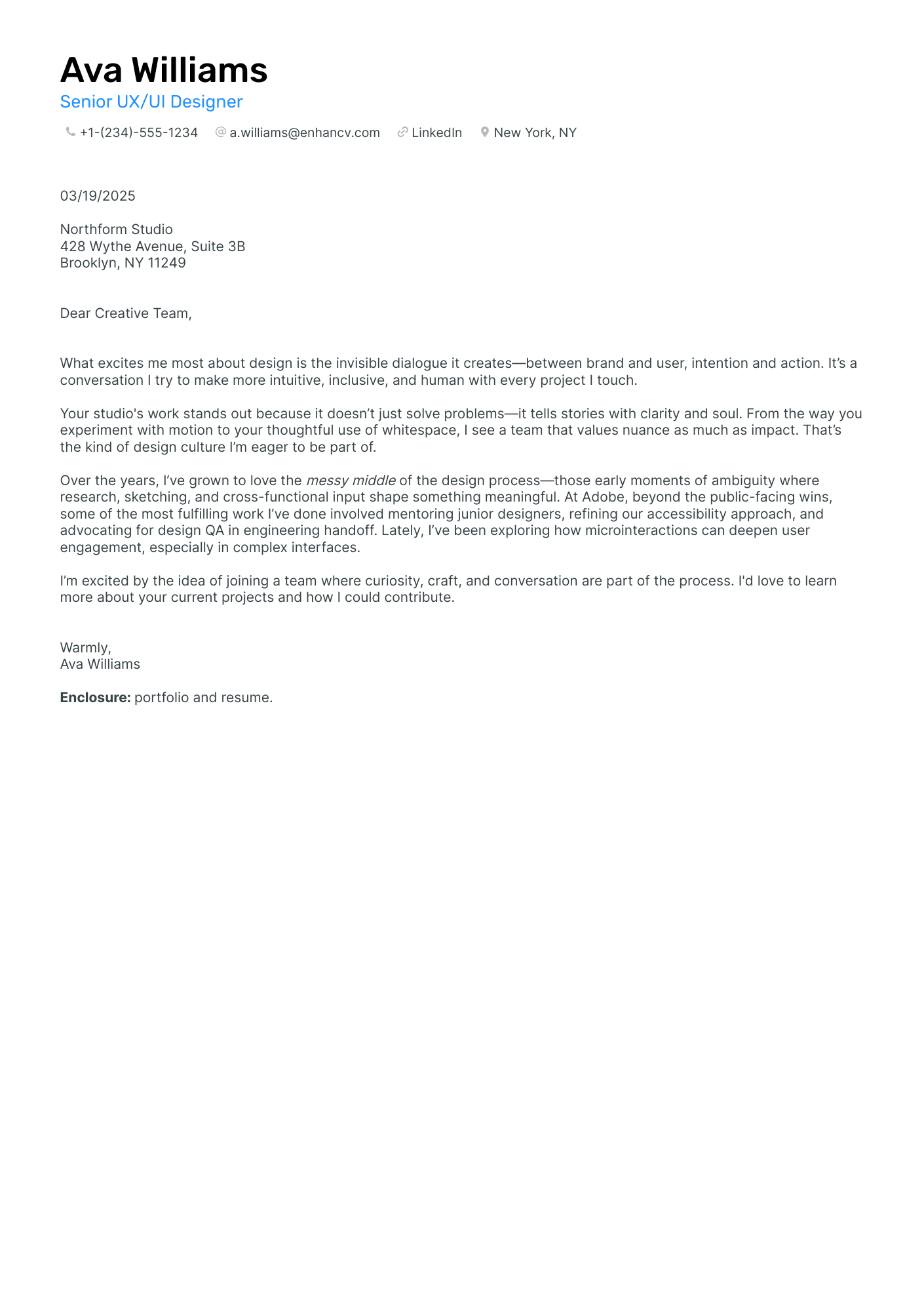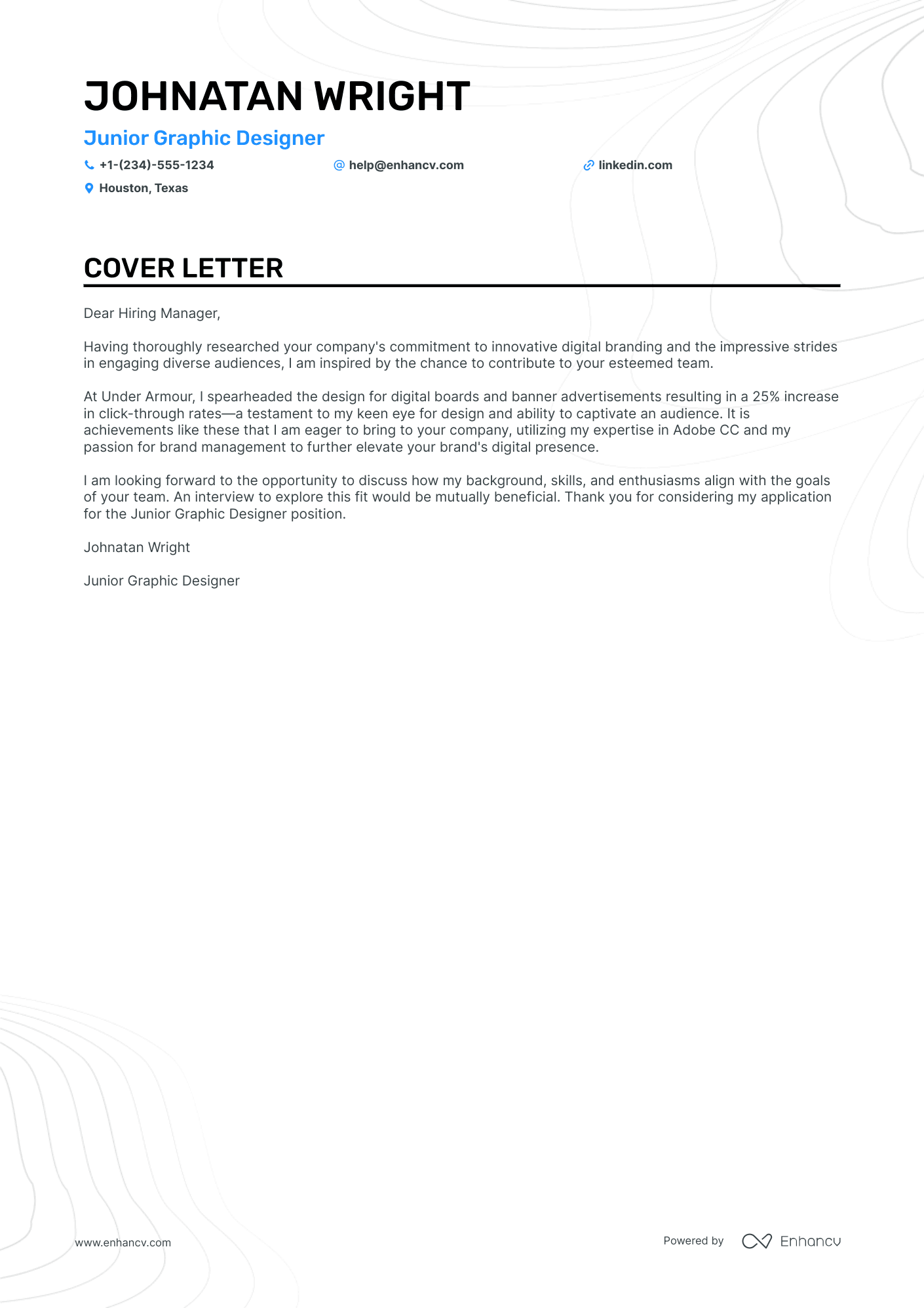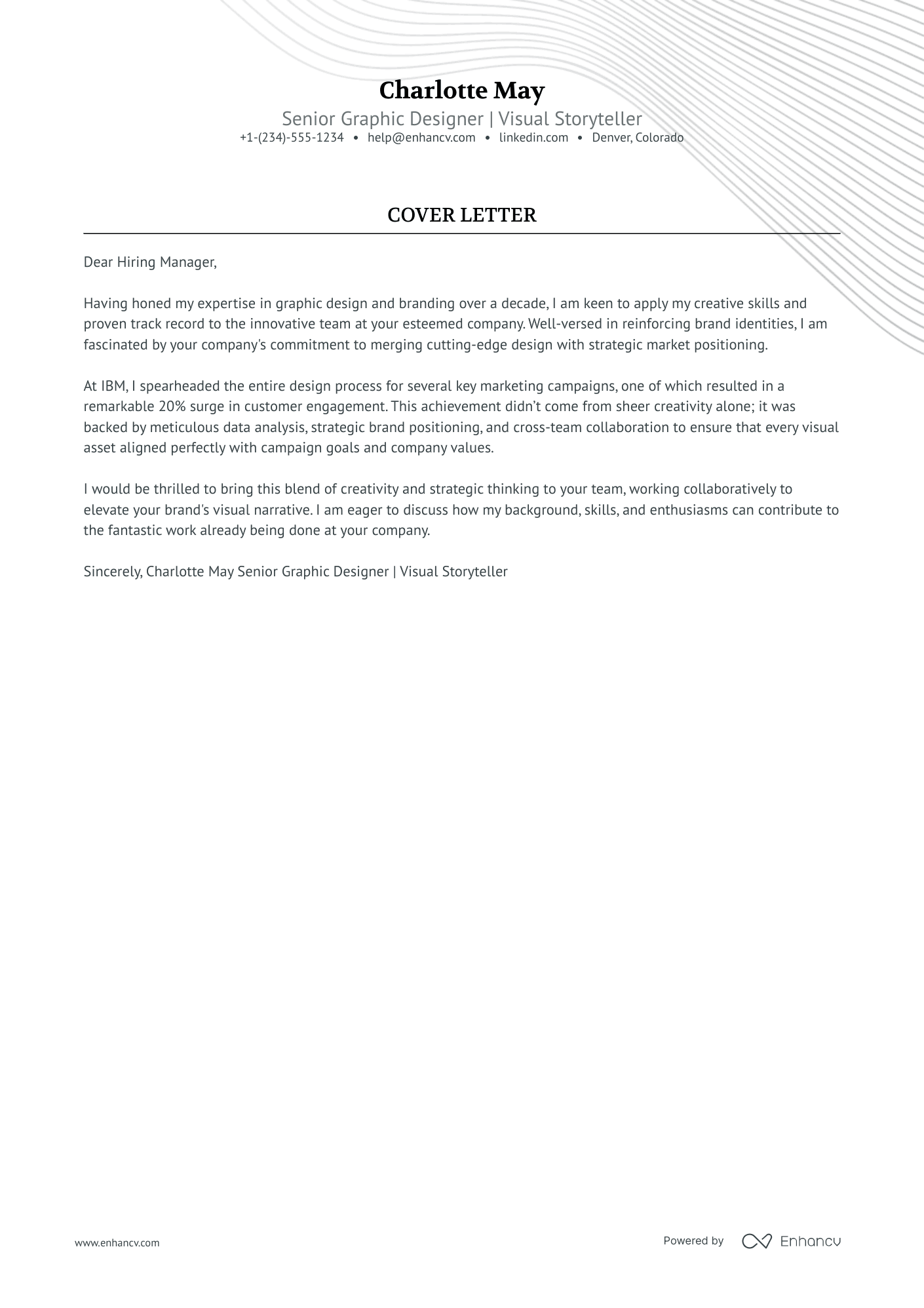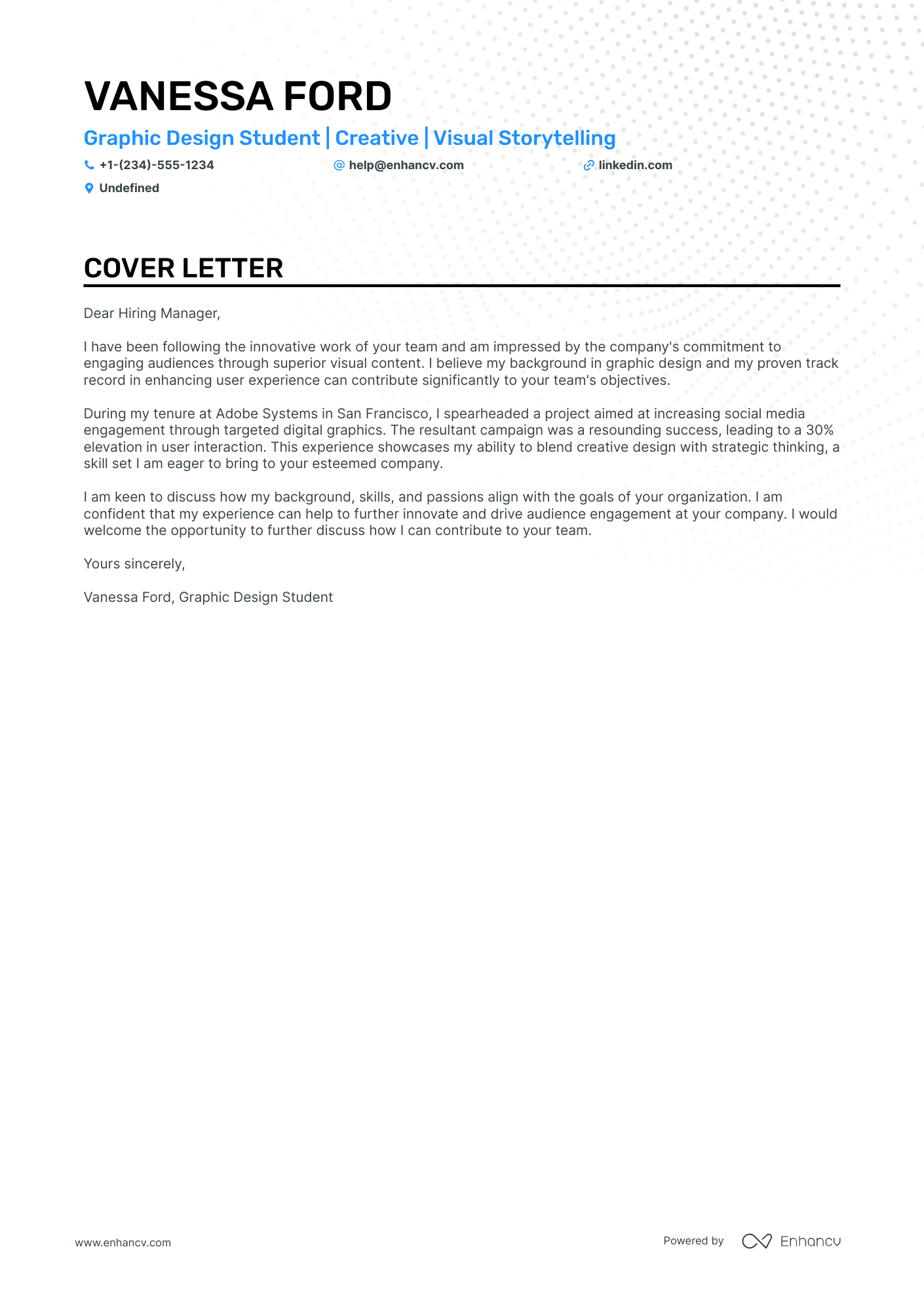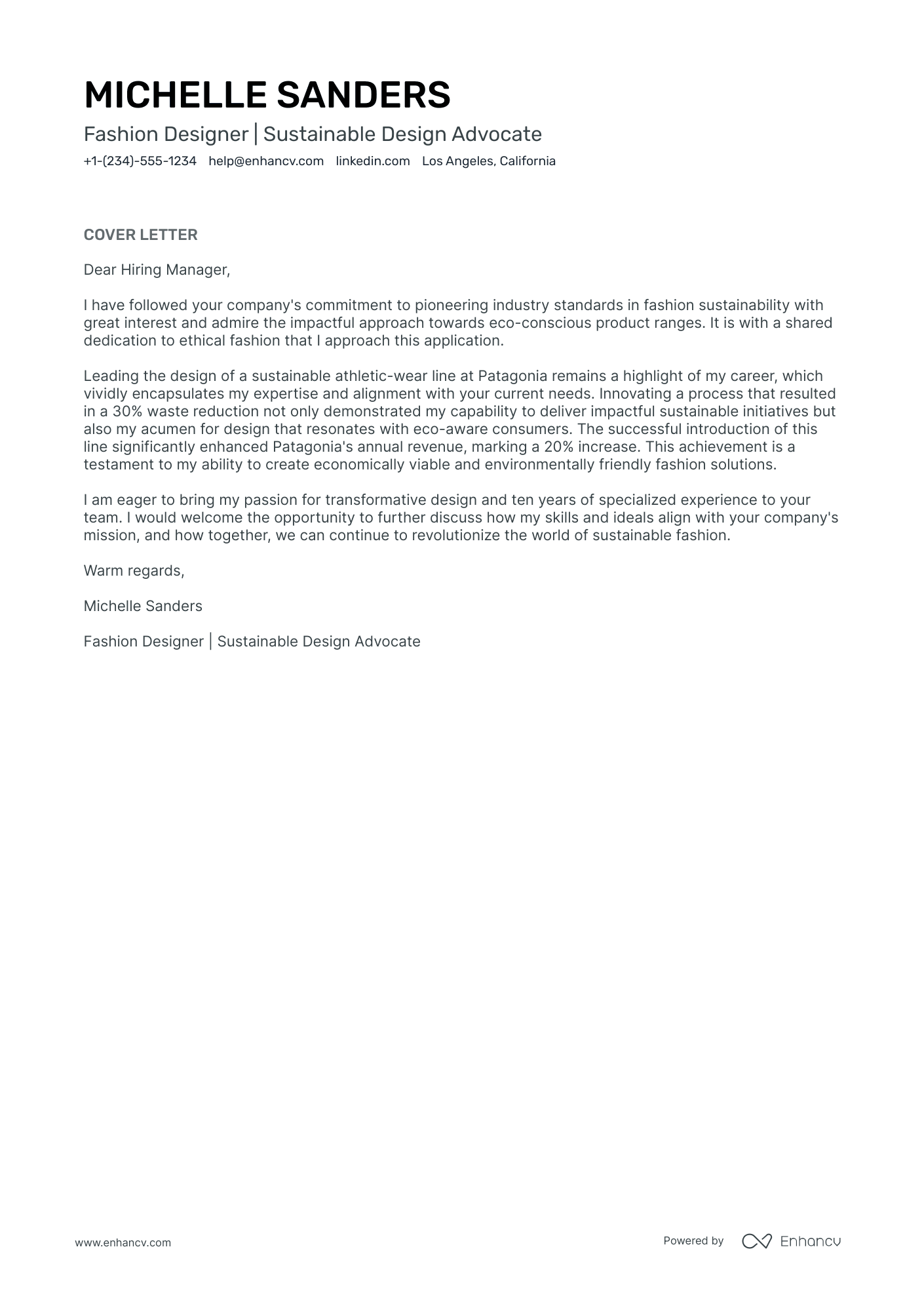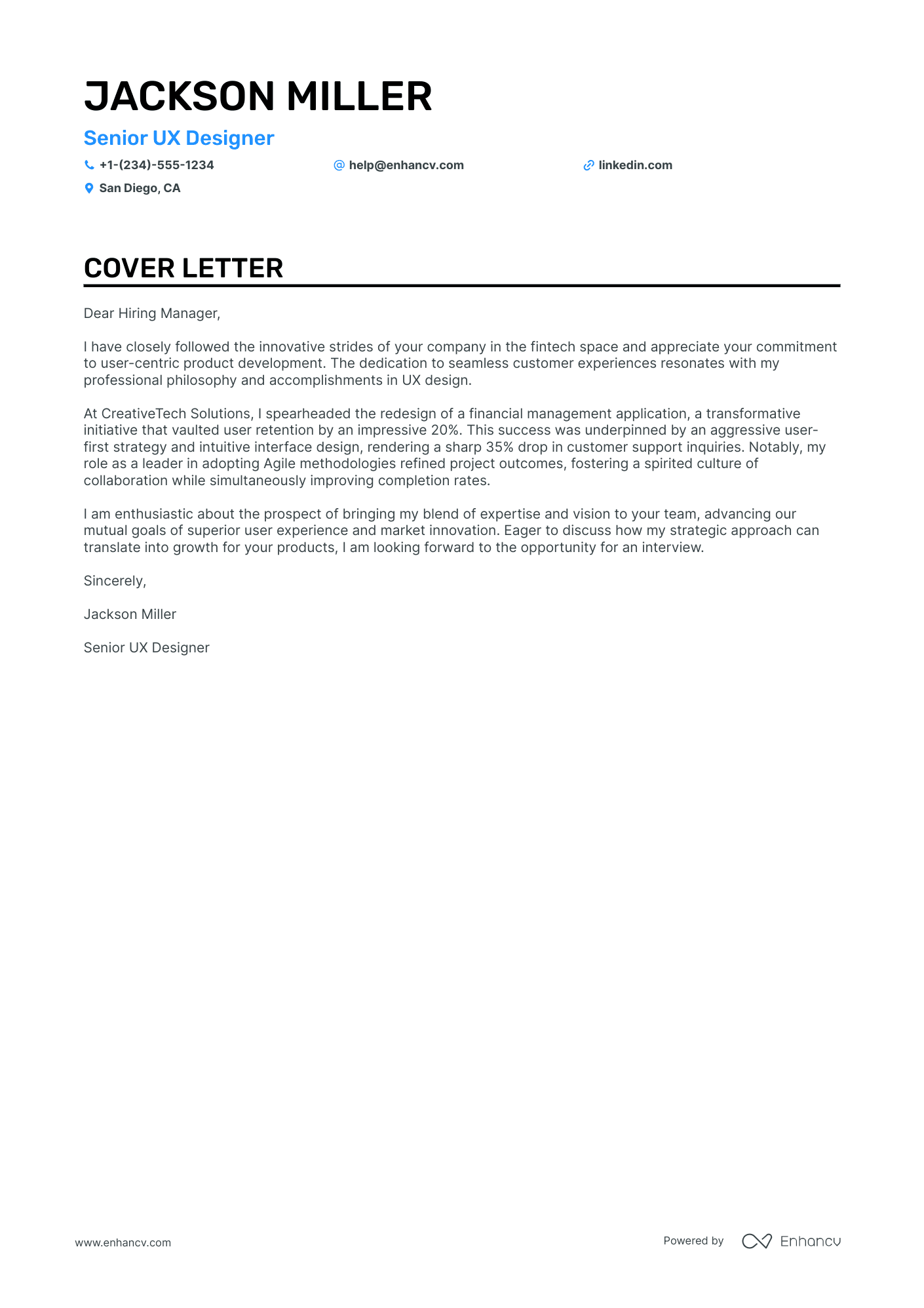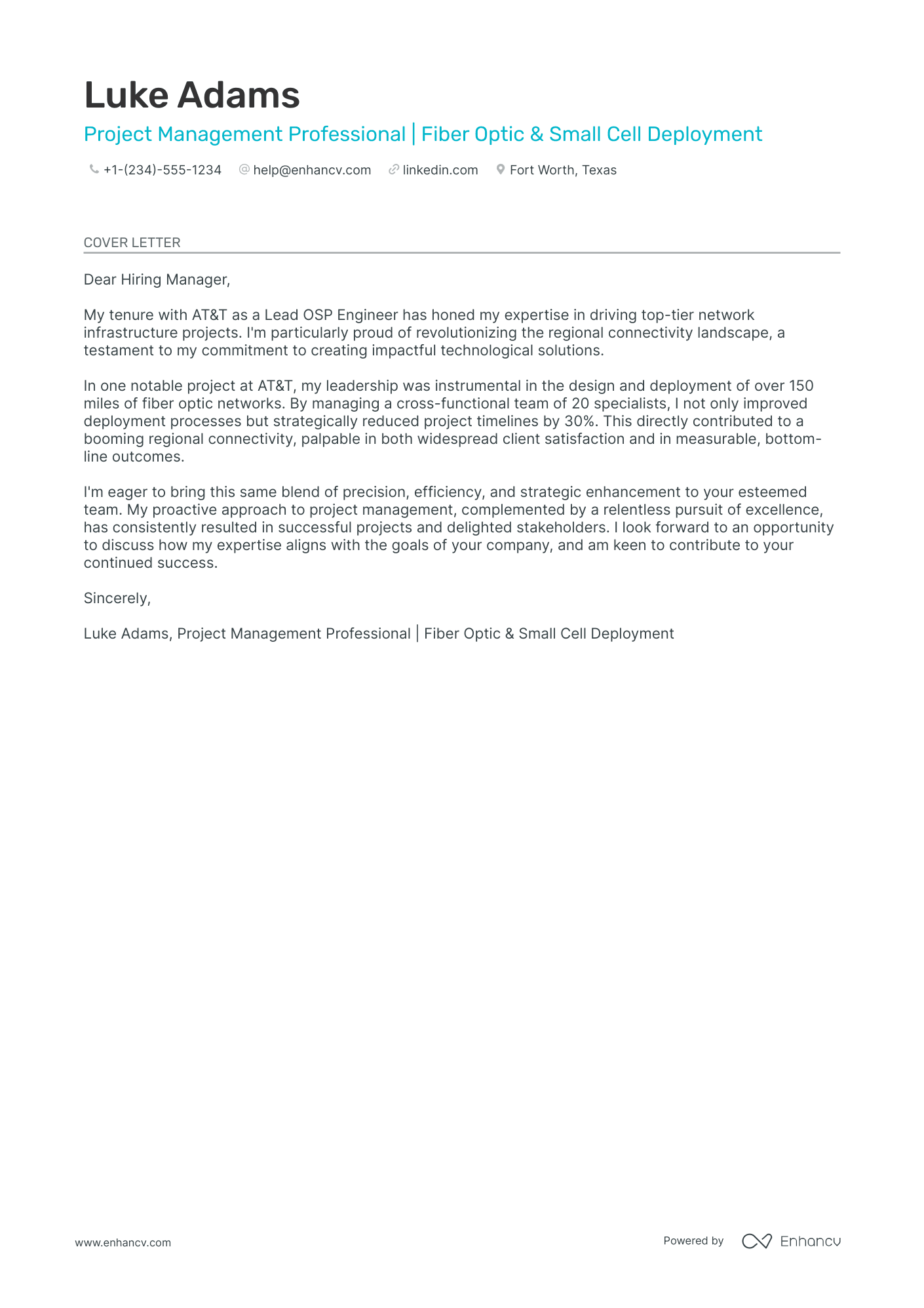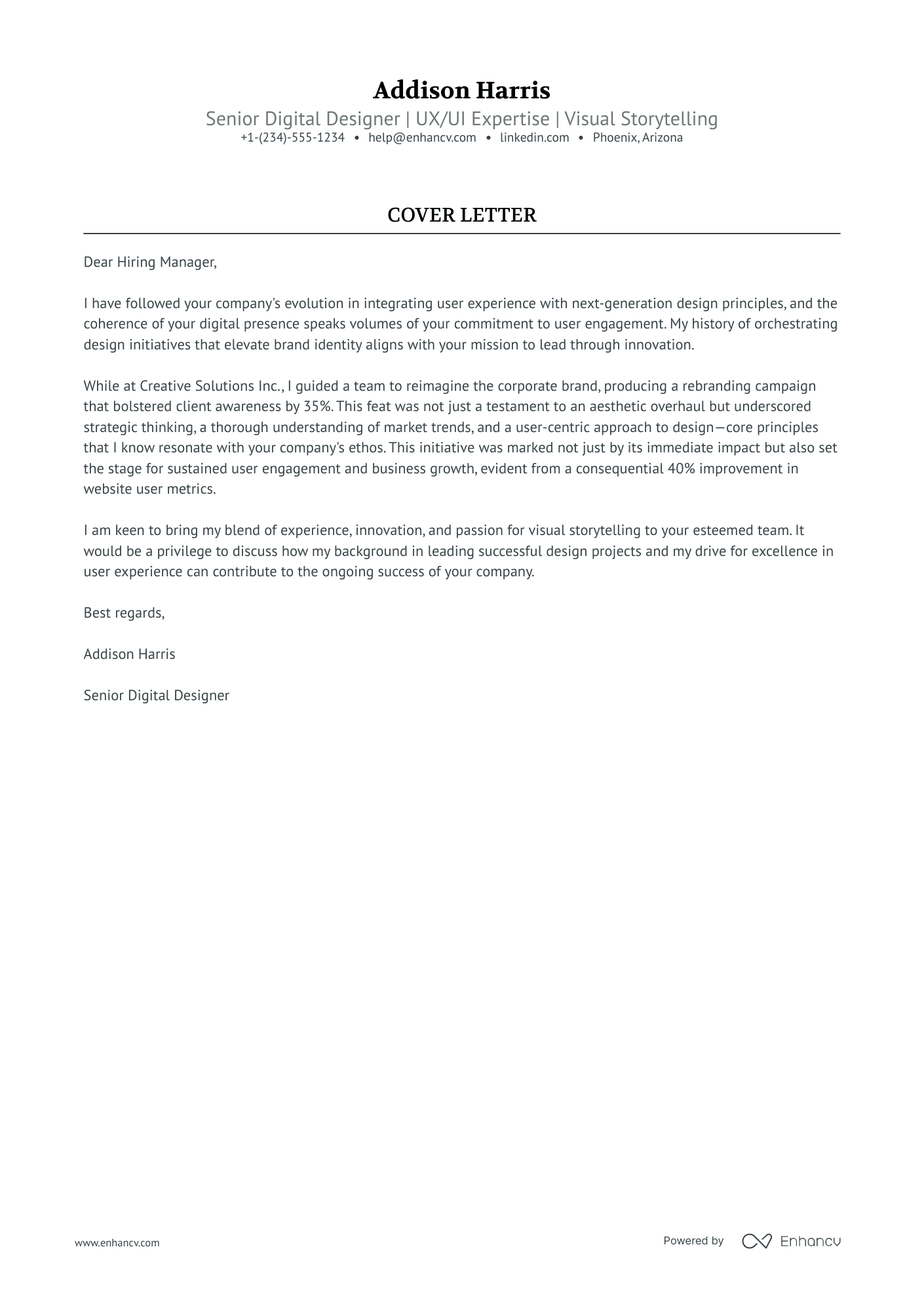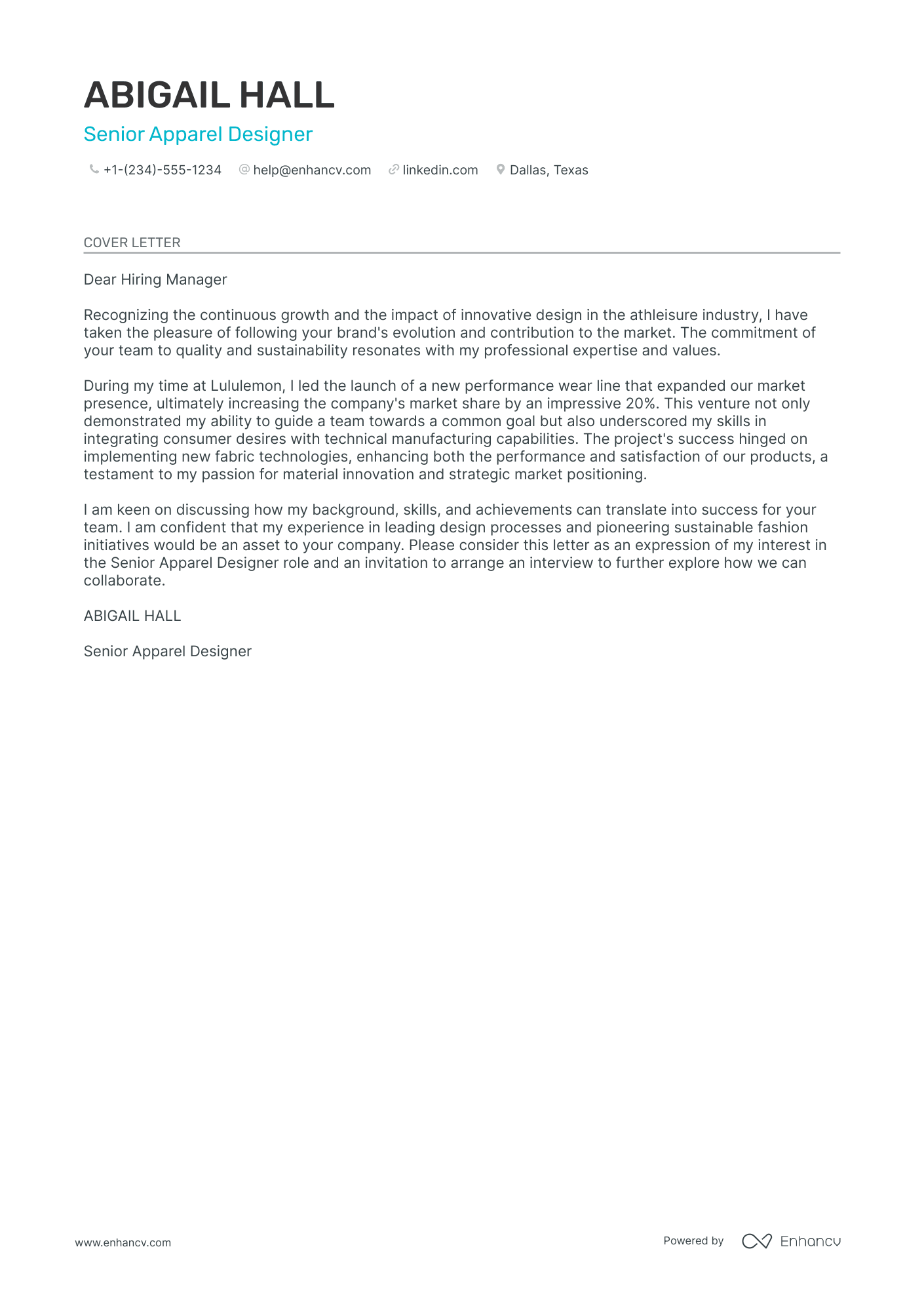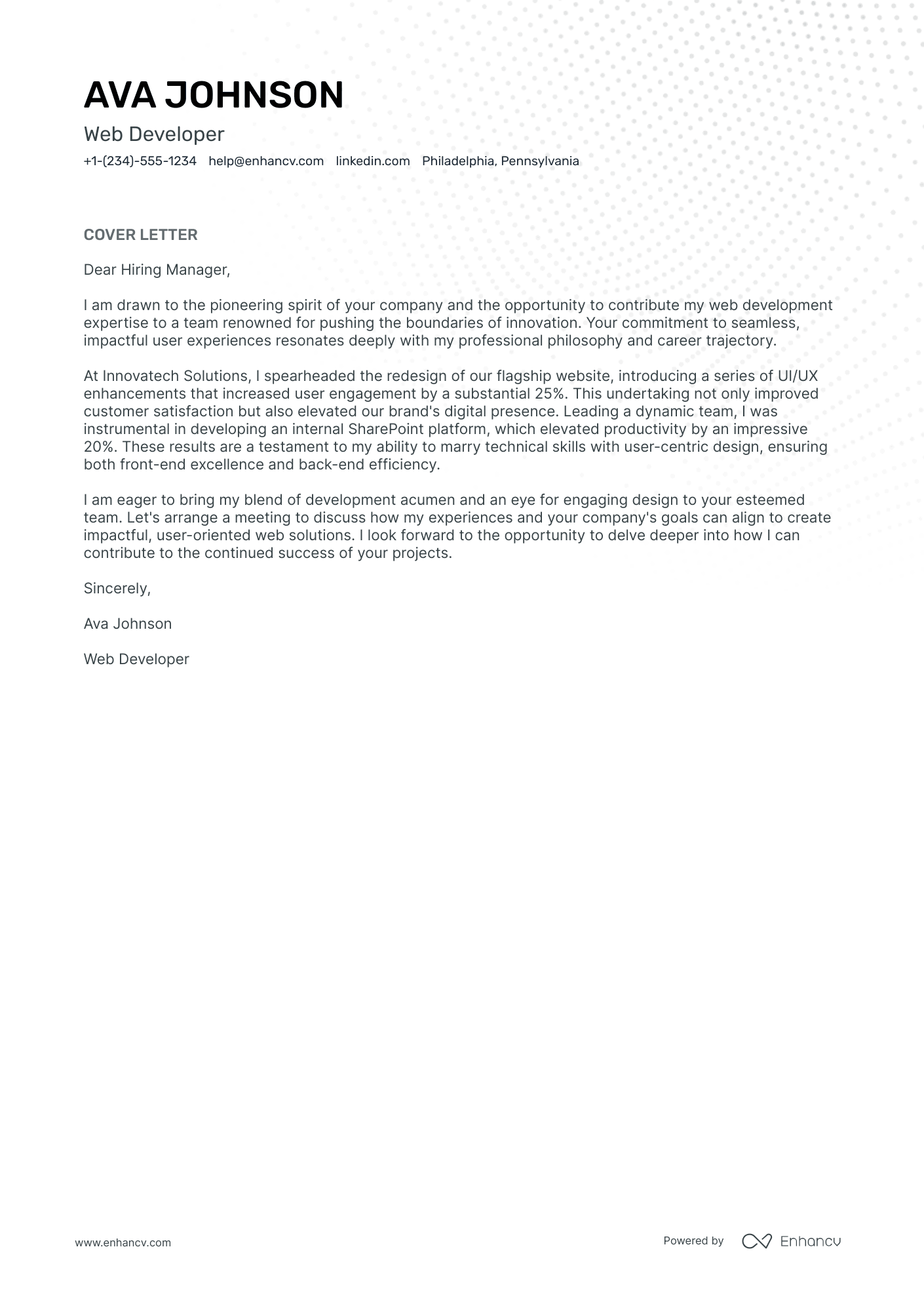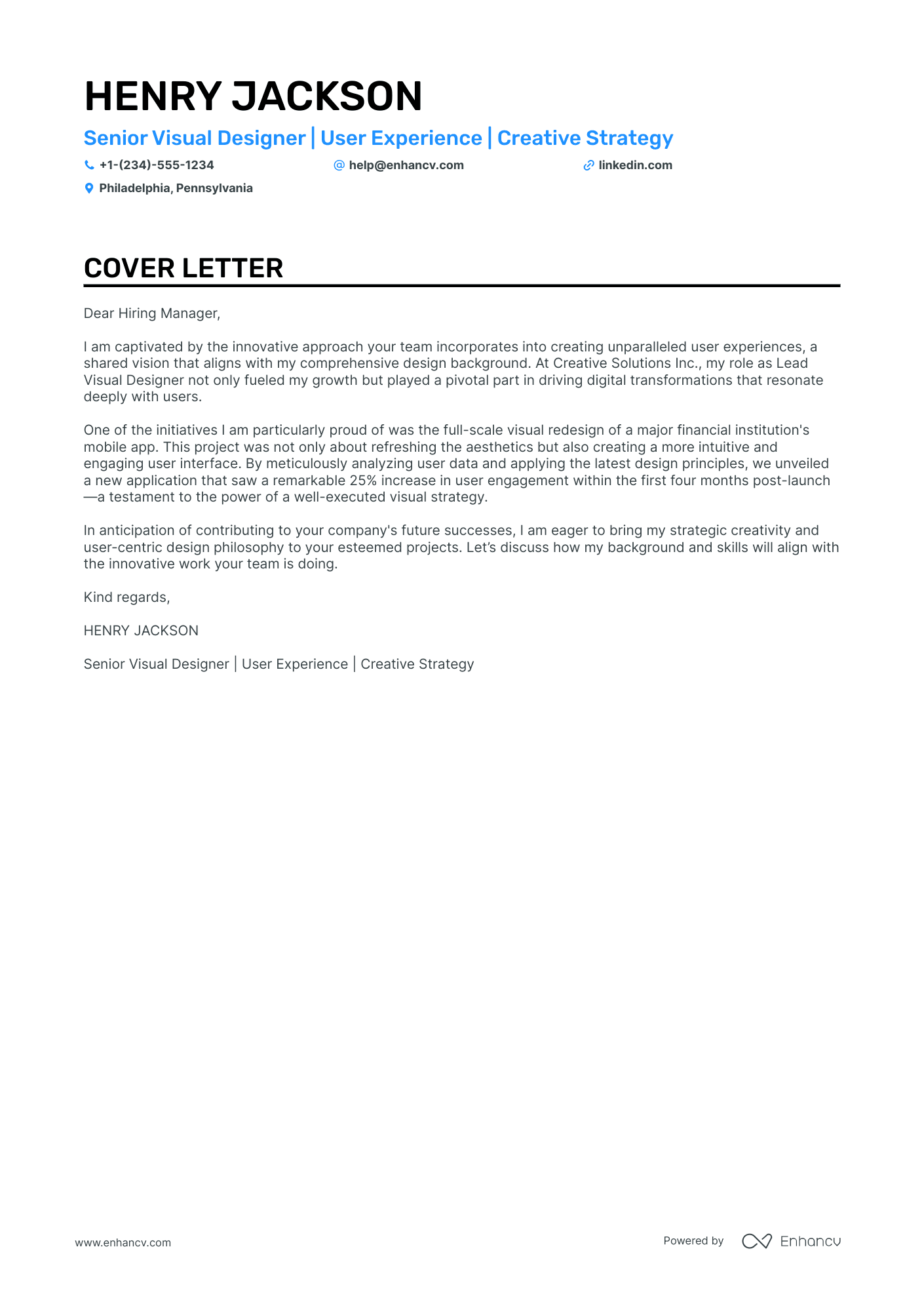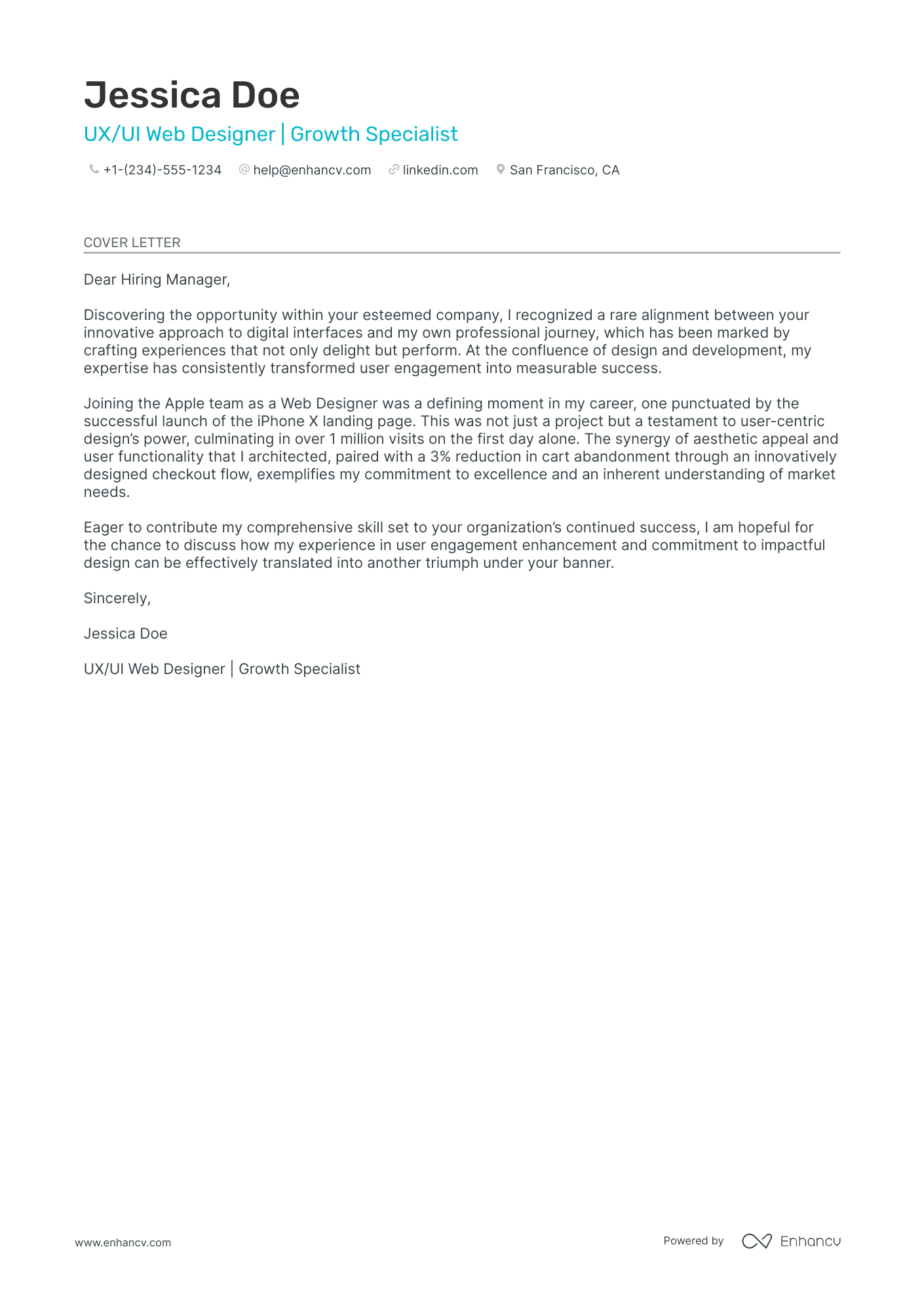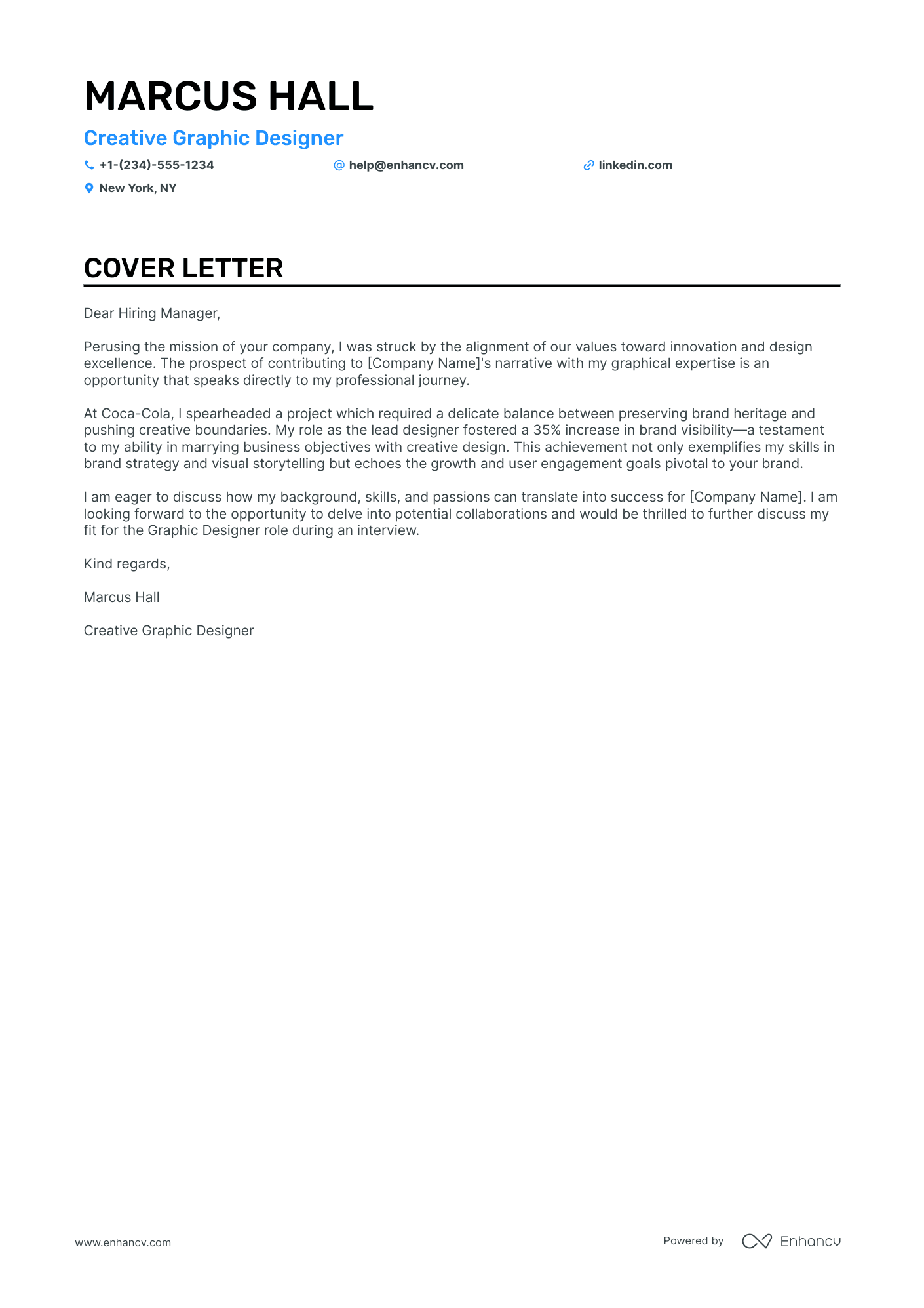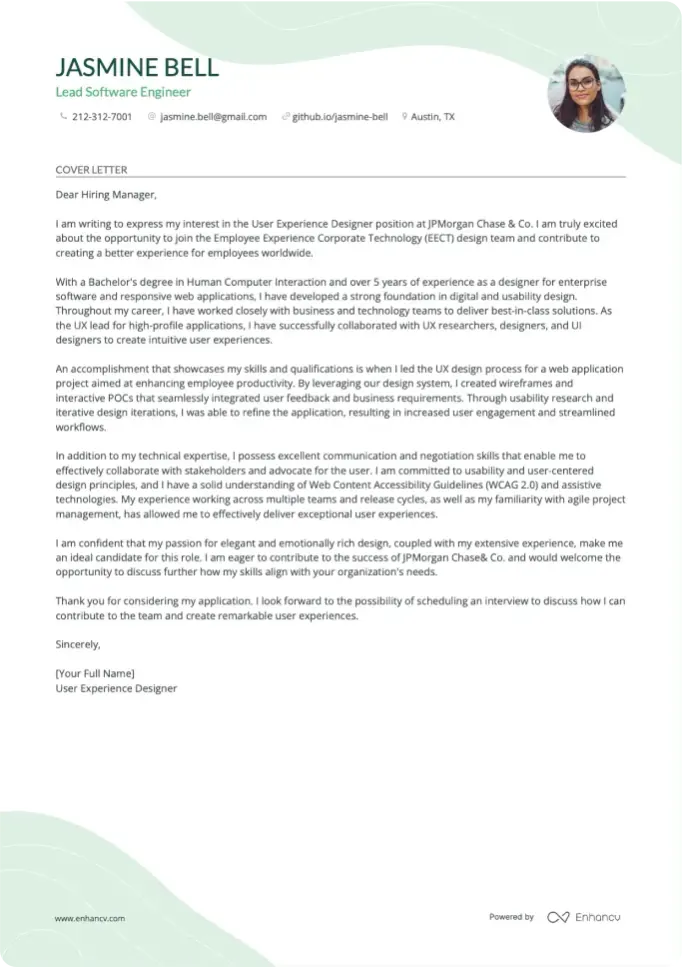Many designers believe their portfolio speaks for itself—and often, it does. A strong portfolio is your most powerful tool, showcasing your skills, style, and creativity in ways words can’t always capture. But even the best-designed projects benefit from a bit of storytelling.
Think of your cover letter as the exhibition text accompanying a gallery show. Sure, the work on the walls is the main event—but the words help guide the viewer’s experience, offering context, intention, and insight.
In the same way, your cover letter adds dimension to your portfolio. It gives hiring managers a glimpse into the thinking behind your designs, your passion for the craft, and why you’re the right fit for their team.
So while your work may show what you can do, your cover letter can tell the story—and together, they make a much stronger case.
Key takeaways
- Your cover letter should complement your portfolio, offering context and storytelling behind your work.
- Design the letter with clarity and alignment in mind—carry over fonts, colors, and layout from your resume when appropriate.
- Use a strong hook in your introduction to reflect your design specialty and recent accomplishments.
- Share relevant achievements using either a short story or bullet points—whichever best reflects your working style.
- If you’re applying with little experience, focus on personal projects, education, passion, and potential.
- End your letter with a confident, professional sign-off and ensure your contact details and links are accuratе.
Drop your resume here or choose a file.
PDF & DOCX only. Max 2MB file size.
Design cover letter example
We’ve tailored the cover letter below to a real designer resume. You can see how they match in design and style. Click on the image to customize this letter with your information.
How to format a designer cover letter
As a designer, you don’t need to be reminded how crucial proper formatting and thoughtful visual choices are. You already understand your resume and cover letter should work together as a cohesive pair.
If you’ve incorporated creative elements into your resume, it makes sense to carry some of that design over to your cover letter. However, even the most visually striking resume might not translate well to a cover letter format.
In those cases, aim to preserve consistency—through colors, fonts, or layout touches—while adapting the design to serve the letter’s main purpose: clarity, readability, and flow.
Think of it this way: your resume is the poster, bold and eye-catching, while your cover letter is the brochure, guiding the viewer through the story. Keep the visual language aligned, but let the content lead.
Avoid overly complex layouts, heavy graphics, or anything that distracts from the message. A clean, well-designed letter with subtle personal branding will always stand out for the right reasons.
Ready to fast-track your application? Upload your resume and let our cover letter generator craft a tailored letter that fits your experience perfectly—no guesswork needed.
Cover letter designs
While creativity is encouraged, clarity and readability should remain the top priorities.
Look out for the following when formatting your design cover letter:
- Choose a professional layout with subtle design elements that reflect your personal branding—think elegant typography, a well-structured layout, and carefully placed color accents.
- Stick to single spacing and one-inch margins, same as your resume, to keep your letter looking polished.
- Aim for a concise cover letter of 250-350 words, structured into short, engaging paragraphs. Avoid long blocks of text—white space improves readability.
- Use the same font in your cover letter as in your resume.
- If appropriate, incorporate a small logo, a color accent from your portfolio, or a custom-designed header—but keep it relevant and functional.
The top sections on a designer cover letter:
- Header: This section includes your name, contact information, and links to your portfolio or design work, making it easy for the recruiter to connect your letter to your visual identity. Ideally, copy your resume header for consistency.
- Greeting: A personalized salutation shows you've done your research and adds a human touch, which is especially important in creative roles where communication style matters.
- Introduction: This is where you quickly capture attention by stating the role you're applying for and giving a strong, relevant reason why you're excited about this particular design opportunity.
- Body: The core of your letter should highlight your most relevant design projects, tools, and creative problem-solving abilities—connecting your experience directly to the company's needs or aesthetics.
- Closing: This section wraps up your letter with a confident call to action, reinforces your enthusiasm, and invites the recruiter to review your work or set up an interview.
Contact information
A small formatting mistake can undermine the impression that you possess the attention to detail designers are expected to have.
Here’s what to focus on:
- Ensure all contact details are correct—even a minor typo in your email or portfolio link could cost you an opportunity.
- Include your full name, phone number, email address, and professional links (Behance, Dribbble, or personal website). Adding your LinkedIn profile is optional but can be beneficial.
- Put the date and the company’s address just below your information to maintain a professional format.
- Link directly to your work rather than expecting the recruiter to search for it. Use hyperlinks where possible.
Save your cover letter with a clear, professional name, such as “FirstName_LastName_Graphic_Designer_Cover_Letter.pdf” to maintain a polished and organized application package.
Sometimes, depending on the employer’s requirements, an e-note might be more appropriate than a cover letter. Check out the table below to learn the differences.
| COVER LETTERS | E-NOTES |
|---|---|
| The classic way to go | Easier to read on mobile devices |
| Follow standard business letter format | Follow a standard email format |
| More formal and longer | Less formal than a cover letter and shorter than one page |
| Enclosed as a separate printed document/attachment | Written directly in the email body |
Key qualities recruiters search for in a designer cover letter:
- Proficiency in design tools: Being skilled in tools like Adobe Creative Suite, Figma, or Sketch proves you're ready to work on real projects.
- User-focused design approach: Recruiters want to see that you design with the end user in mind, not just for looks.
- Experience with branding: Ability to create or follow a brand style and keep it consistent across all materials.
- Team collaboration skills: Design is rarely done alone—being able to work well with developers, writers, and marketers is key.
- Creative problem-solving: Companies value designers who can come up with smart, unique solutions to visual challenges.
Now that we know what your cover letter should look like and what its main components are, let’s move on to its content.
How to write your designer cover letter salutation
Your cover letter might radiate with creativity, but the greeting should stay straightforward and professional. Personalization is key—addressing the hiring manager by name shows attention to detail and that you’ve done your homework.
Take a moment to check the job posting, company website, or LinkedIn to find the right contact. If you can’t find a specific name, opt for a neutral but warm greeting. Avoid outdated phrases like “To Whom It May Concern,” and go with something that feels current and human.
What to use when you don’t know the hiring manager’s name
- Dear Hiring Manager,
- Dear Creative Team at [Company Name],
- Hello [Company Name] Design Team,
- Greetings [Company Name] Creative Department,
- Dear [Company Name] Studio Team,
Next up, let’s introduce ourselves.
How to write your designer cover letter intro
Did you recently take part in an exhibition? Are you illustrating a children’s book or designing the interior of a trendy new restaurant?
Maybe you just launched a sleek web redesign for a nonprofit, helped rebrand a local coffee shop with a bold new visual identity, or led UX research that boosted in-app engagement by 30%.
These are all strong, specific hooks that can immediately grab a hiring manager’s attention and set your cover letter apart. The introduction is your chance to highlight something you're proud of, reflect on your design niche, and show enthusiasm for the role—all within a few lines.
Whether you’re writing a cover letter for a graphic designer, illustrator, or UX/UI specialist, opening with a recent, relevant accomplishment or passion project is a powerful way to stand out.
Cover letter intro
I recently wrapped up the visual identity for a sustainable skincare startup—crafting everything from packaging to social templates. Projects like this fuel my passion for purpose-driven design, which is why I’m excited about the graphic designer role at Glossier. Your bold, minimalist aesthetic closely aligns with my own design style and experience.
You’ve got your readers engaged, so keep the momentum and impress them with your work achievements!
How to write your designer cover letter body
The body of your cover letter is your chance to show—not just tell—why you’re the right designer for the job. Instead of listing generic tasks like "designed logos" or "created wireframes," focus on real-world stories and results that reflect your creative process, technical skill, and ability to solve problems visually.
Design isn’t just about aesthetics—it’s about communication, function, and impact. Regardless of the specific design field you're in, share examples that show how you brought ideas to life, improved user experience, or helped a brand connect more deeply with its audience.
When crafting the body of your cover letter, you have two effective ways to present your qualifications: through a short narrative or a bulleted list of highlights. Each approach works well—you just need to pick the one that best reflects your working style and career story.
Narrative approach
If you’re an illustrator, interior designer, or graphic designer who thrives on storytelling and concept development, the narrative approach allows you to present the influence of a single, powerful project. It’s ideal for explaining the creative process, collaboration, and the “why” behind your design choices.
Cover letter body example #1
In my last role with a boutique branding agency, I led the redesign of a nonprofit’s website. By streamlining navigation and improving visual hierarchy, we reduced the bounce rate by 40% and increased donations by 25% within the first month. Projects like this energize me—solving problems through design and making a measurable impact.
Bulleted highlights approach
On the other hand, if you’re a web designer, UX/UI specialist, or someone who works across fast-paced environments and has multiple achievements worth highlighting, the bulleted approach helps hiring managers quickly grasp the range of your experience and the results you’ve delivered.
Cover letter body example #2
- Designed a responsive e-commerce website that boosted mobile conversion rates by 32%.
- Illustrated a children’s book now featured in independent bookstores across 3 countries.
- Collaborated with interior architects to develop branded environmental graphics for a co-working space.
- Created social media templates and animations that increased Instagram engagement by 50%.
- Contributed to a full rebranding project for a fintech startup, resulting in a successful relaunch.
How do I write a designer intern cover letter with no experience
What if you’re at the very beginning of your designer career? No agency gigs, no product launches, no serious case studies—yet.
That’s completely fine. Everyone starts somewhere, and your cover letter is a great place to show potential, not just experience.
Focus on the following:
- Passion for design: Talk about what drew you to design in the first place. Whether it was sketching in the margins, building websites for fun, or rebranding fictional companies in your free time—your curiosity counts.
- School or self-initiated projects: Include class projects, portfolio pieces, or personal design challenges (like a Behance project or a Daily UI series). These can show creativity and commitment even if they aren’t client-based.
- Transferable skills: Highlight soft skills like communication, teamwork, time management, or research—especially if gained from school, part-time work, or volunteering.
- Familiarity with tools: Even if you haven’t worked professionally, showing you're confident in tools like Figma, Adobe XD, Illustrator, or Canva can make you a stronger candidate.
- Tailored interest in the company: Show you understand their aesthetic, mission, or recent work—and why you’re excited to learn from their team.
Okay, you know how to structure your experience regardless of your experience level. Let’s close the cover letter effectively.
How to write the closing paragraph
There's no need to put on a show—you’ve already caught the employer’s eye with your cover letter’s intro and body. Your closing is the perfect opportunity to recap your strengths, express genuine interest, and invite the recruiter to get in touch.
Let’s see an example:
Cover letter closing
Joining the team at Pentagram would be an exciting opportunity to contribute to bold, thoughtful design work that makes an impact. With a foundation in visual storytelling and a strong eye for detail, there's a real alignment between my approach and your creative vision. Thank you for considering my application—looking forward to the chance to connect and explore how I can support your team.
Professional sign-off
Your sign-off is the final touch of your cover letter. Always thank the hiring manager for their time and consideration, and choose a professional closing that fits the tone of your letter and your relationship—or lack of one—with the recipient.
If you know the hiring manager’s name or are applying to a creative team with a more casual culture, go with a warm and elegant sign-off like:
- Kind regards,
- Best regards,
- Sincerely,
- Warm regards,
If the recipient is unknown or the company feels more formal, opt for a classic close:
- Respectfully,
- With appreciation,
Always sign off with your full name. Optionally, you can state you’ve attached your resume and/or portfolio under your name—like so:
Resume and portfolio attached for reference.
Conclusion
A well-crafted designer cover letter doesn’t just repeat your resume—it adds depth, context, and personality to your work. Use it to connect the dots between your skills, your portfolio, and the company you want to design for.
Designer cover letter examples
By Experience
Junior Graphic Designer
Senior Graphic Designer
Graphic Design Student
Design Intern
By Role
